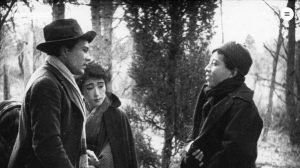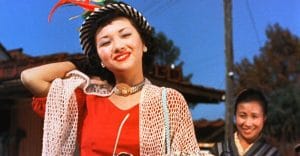1. 100 years
To start with the title: Shochiku 100 at Eye is a centenary celebration. 'A century of film classics from Japan' is the subtitle. A celebration with some corona delay. Because in 2020, Japan's Shochiku celebrated its centenary as a film studio. Shochiku you say? Well, it's high time we knew that name. After all, it should sound as familiar as those of American studios like Warner Bros or Metro Goldwyn Mayer.
After all, the Japanese film industry was an important counterpart to the American one early on, and Shochiku is one of Japan's largest and oldest film companies. It is also good to know that where in America public film and arthouse are more or less separate worlds, we find that separation much less at Shochiku.
As a film studio, incidentally, Shochiku is no longer active. It does, however, as a co-producer, distributor and as owner of Movix, a nationwide chain of state-of-the-art multiplex theatres.
Eye presents with the programme Shochiku 100 from 3 February, fourteen titles that span a century of Japanese film history, including works by acclaimed filmmakers such as Masaki Kobayashi, Takeshi Kitano and Nagisa Oshima. The icing on the cake are four restored films by the acclaimed Yasujiro Ozu, which will be shown not only at Eye but also in film theatres across the country in the near future.
2. Souls on the Road

Shochiku got off to a promising start. The oldest title in the Eye programme is Souls on the Road (1921) by Minoru Murata. One of the first Shochiku films, a classic that mixes Japanese traditions with then Western avant-garde influences. On Christmas Eve, after a trip through the snow, an unsuccessful violin maker knocks on the door of his father's house. Unfortunately, the latter wants nothing to do with his son. Meanwhile, two escaped prisoners hide in the woods.
Relying on stories by Maxim Gorki and Wilhelm August Schmidtbonn, Murata interweaves three storylines, using a variety of techniques new to Japan such as flashbacks, flashforwards, dissolving views and fade-outs. Film historian Mark Cousins calls this film about the meaning of charity 'a milestone'. In Eye with live music by West Side Trio plus!
3. Window on Japan
Together, the 14 titles, plus those four by Ozu, offer not only a kind of cross-section of 100 years of Japanese cinema, but also a window on Japan. They range from the tragic police film Castle of Sand (one of the best Japanese audience films according to Eye) to the contrarian Yakuza drama cut with absurdism and ghoulish humour Sonatine (1993), in which gangsters in a sunny holiday landscape play weird games and await fate. Although initially flopped domestically, Takeshi Kitano definitively established his name abroad with it.
I highlight one more thing. For example, I see the integral screening of the three parts of The Human Condition, Masaki Kobayashi's magisterial war drama. In it, we follow the fortunes of the well-meaning but naive Kaji, who is initially an overseer in a forced labour camp, later a soldier in the Japanese army and finally a prisoner of war of the Russians. In 1989, I saw this epic at the Rotterdam Film Festival, a great, unmissable experience.
Before Nagisa Oshima became known here as creator of, among others L'Empire des senses (1976) and Merry Christmas Mr Lawrence (1983), he had a surprising box-office success in Japan in 1960 with Naked Youth. As a reward, the Shochiku studio (briefly) gave him carte blanche. Oshima seized that opportunity and made the radical and subversive Night and Fog in Japan, a classic that is now included in the Eye programme. A politically charged film about the failed legacy of Japan's student uprisings. Shochiku was shocked, and withdrew the film just days after its release.
Lots of awards, including an Oscar, were in 2009 for Departures by Yoyiro Takita. A beautifully understated story with dark-humorous touches about what an unexpected turn of events in life can do. A dismissed cellist goes to prepare the dead for their journey to the afterlife. He has talent, but keeps it a secret, because the profession of deposition is not held in esteem in Japan.
And when it comes to portraying Japanese family relationships, Yasujiro Ozu's films are, of course, unsurpassed.
4. The first Japanese colour film

To celebrate its 30th anniversary, Shochiku produced the first Japanese colour film in 1951: Carmen Comes Home. A curiosity really, but a very entertaining one, which, like many other films in the programme, is also a kind of mirror of Japanese society. A stripper from Tokyo returns with her girlfriend to her conservative native village, where she inevitably causes a stir. Satirical comedy set against the backdrop of beautiful landscapes photographed in Fujicolour. By Keisuke Kinoshita, one of the directors most closely associated with Shochiku.
5. Yasujiro Ozu, master of telling simplicity
In Japan itself, the subdued family dramas by the much admired Yasujiro Ozu (1903-1963) were initially considered 'too Japanese' for export to the West. An ironic misunderstanding, it later turned out. It may be that Ozu always resisted the temptation to imitate Hollywood's melodramatic film style, yet his sober, lucid films, mostly centred around family relationships, immediately strike a chord. Ozu is very Japanese and at the same time universal.
When the film magazine Sight & Sound conducted a worldwide poll in 2012, more than 350 filmmakers indicated Ozu's Tokyo Story consider the best film of all time. For directors like Jim Jarmusch, Abbas Kiarostami and Aki Kaurismäki, Ozu's work is considered a major source of inspiration. In 1972, Paul Schrader (then not a filmmaker but a critic) published the still available Transcendental Style in Film. A famous book-length essay in which, among other things, he Tokyo Story analyses and discovers a more spiritual film form here. A narrative form in which tensions and contradictions do not get their denouement through a conventional dramatic construction. Instead, it comes via a sudden emotional moment to a calm sense of deeper understanding and acceptance. Zen?
Ozu remained loyal to Shochiku throughout his career. In addition to Tokyo Story (1953) also shows Eye The Flavour of Green Tea Over Rice (1952), Early Spring (1956) and Tokyo Twilight (1975).
6. Tokyo Story

The numerous studies devoted to Ozu might give the impression that his work is mainly for seasoned cinephiles. Nothing could be further from the truth. Wherever there are families, parents and children, the same misunderstandings and discomforts are at play, and Ozu draws them out for us with crystal clarity.
On a first viewing of his most famous film, Tokyo Story, it is especially striking how modest this subtle but ultimately deeply moving family drama is. In it, an elderly couple visits their children in Tokyo. Between the pleasantries and excuses, it soon becomes clear that these children are mainly busy with themselves. They have no time for their parents. They stay in a hotel full of noisy party people. Only daughter-in-law Noriko, who was married to the son killed in the war, tries to be nice.
Much drama smoulders beneath it all, but overtly emotional scenes are limited to one unexpected cry and a beautiful drunkenness. Followed by the acceptance of the realisation that despite all the disappointments, life goes on as usual. Tokyo Story, as well as other work by Ozu, shows a keen insight into human relationships and feelings. By stripping away all frills, and with a touch of melancholy and subtle poetry, Ozu puts down exactly the essence.
Shochiku 100 is from 3 February to 2 March at Eye Filmmuseum, Amsterdam. The four restored Ozu titles will also be released in movie theatres.
